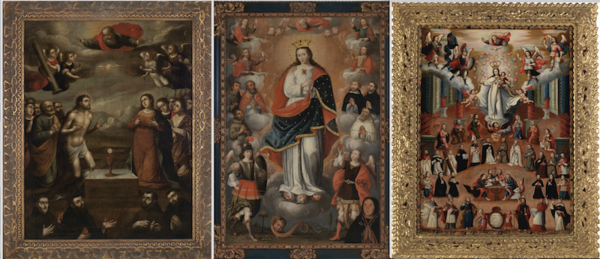The Snite Museum of Art Receives Long-Term Loans of Spanish Colonial Art from the Carl & Marilynn Thoma Art Foundation
Notre Dame, IN: The Snite Museum of Art installed recent loans from the internationally renowned Carl & Marilynn Thoma Art Foundation. Three paintings dating from the seventeenth and eighteenth centuries, drawn from the Foundation’s extraordinary holdings, complement the Museum’s existing collection of Spanish Colonial works to expand our understanding of the period.
This new loan follows an earlier one from the Thoma Foundation of thirteen works that were shown in the 2020 exhibition Divine Illusions: Statue Paintings from Spanish Colonial Peru, organized by Professor Michael Schreffler of the University of Notre Dame’s Department of Art, Art History & Design. In 2023 When the new Raclin Murphy Museum of Art debuts in 2023, the University will receive five different works from the Foundation to replace the three currently exhibited. Those loans are slated to extend through 2026.
“The Thoma family have become very good, trusted friends of the Museum. It is an honor to host masterpieces from their extensive collection that can be appreciated, studied, and nourish us all,” said Joseph Antenucci Becherer, director of the Snite Museum of Art.
"The paintings on loan from the Thoma Art Foundation are windows into a fascinating world of social interaction and Christian devotion in Spanish Colonial South America. Our students and all visitors to the Snite will benefit from the unique opportunity to study and reflect on these visually compelling works of religious art" notes Michael Schreffler, Professor of Art History at the University of Notre Dame.
Image 1) Gregorio Vásquez de Arce y Ceballos, Allegory of the Eucharist with the Virgin Mary and Saints, c. 1670s, Oil on canvas. Courtesy of the Carl & Marilynn Thoma Art Foundation. (photo: Jamie Stukenberg)
Most paintings from colonial South America are unsigned. However, a few artists did sign their works, enabling experts to attribute unsigned works to their hands. One such known artist is Gregorio Vásquez de Arce y Ceballos (1638–1711), whose oeuvre is considerable. His Allegory of the Eucharist, which was probably based on an engraving, portrays the Catholic doctrine of transubstantiation in which the bread and wine of the Eucharist is transformed into the body and blood of Christ.
Image 2) Unidentified artist, Virgin of the Immaculate Conception with Saints, Angels and Indigenous Donor, 18th century, Oil and gold on canvas. Courtesy of the Carl & Marilynn Thoma Art Foundation. (photo: Jamie Stukenberg)
This painting of the Virgin of the Immaculate Conception follows the traditional iconography of the central figure by showing the Virgin clothed in a white tunic covered by a blue mantle. Satan, as a serpent with a human face, lies vanquished on the ground. At the top of the canvas are the four Evangelists—Saints Matthew, Mark, Luke, and John—shown holding ribbons inscribed with four of the symbols of the Virgin’s immaculacy: the Tower of David, the Temple of Solomon, the City of God, and the Spotless Mirror. She is accompanied by a variety of saints. At lower right is a portrait of the donor, an indigenous woman who must have been a member of an important clan.
Image 3) Cipriano de Toledo y Gutiérrez, Our Lady of Mercy with Saints, 1764, Oil and gold on canvas. Courtesy of the Carl & Marilynn Thoma Art Foundation. (photo: Jamie Stukenberg)
In 1997, the Thoma Foundation acquired a version of this subject, Our Lady of Mercy with Saints, that was dated 1771, but bore no signature. More recently, another version of the subject was acquired by the Foundation. That painting, like yet another painting in a French private collection, is signed by Cipriano de Toledo y Gutiérrez. The existence of the three nearly identical paintings—with others possibly extant—tell us a great deal about the workshop practices of Cuzco painters. Although much has been written about works created for the art market, two of these three works were clearly commissioned by devotees of Our Lady of Mercy and the Mercedarian order. This multifigured composition may well have been based on an engraving.
